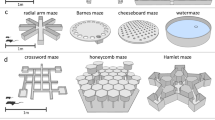Abstract
Although mazes have been widely used in studying phototaxis, geotaxis, and, more recently, learning inDrosophila, there is no uniformity in maze design, and little is known about the effects such apparatus differences may have on behavior. The new maze design described here is based on T-junctions, molded individually in acrylic, and provides an inexpensive and standardized means of building mazes to any desired specification. The need for uniformity in maze design is demonstrated with an experiment on three variables at the start of a maze that affect the subsequent response of four strains ofD. melanogaster in different ways. Some implications for futureDrosophila research using mazes are considered.
Similar content being viewed by others
References
Dingle, C. D. (1962). The non-random behaviour ofAleochara bilineata Gyll. (Coleoptera Staphylinidae) in a Y-maze with neither reward nor punishment in either arm.Anim. Behav. 10:118–125.
Dobzhansky, Th., Levene, H. and Spassky, B. (1972). Effects of selection and migration on geotactic and phototactic behaviour ofDrosophila. III.Proc. Roy. Soc. Lond. Ser. B 180:21–41.
Ewing, A. W. (1963). Attempts to select for spontaneous activity inDrosophila melanogaster.Anim. Behav. 11:369–378.
Ewing, A. W. (1967). Genetics and activity inDrosophila melanogaster.Experientia 23:330.
Hadler, N. M. (1964). Genetic influences on phototaxis inDrosophila melanogaser.Biol. Bull. 126:264–273.
Hay, D. A. (1973). Effects of genetic variation and culture conditions on the social behavior ofDrosophila melanogaster.Behav. Genet. 3:107–119.
Hay, D. A. (1975). Strain differences in the maze-learning ability ofDrosophila melanogaster.Nature 257:44–46.
Heisenberg, M., and Götz, K. G. (1975). The use of mutations for the partial degradation of vision inDrosophila melanogaster.J. Comp. Physiol. 98:217–241.
Hirsch, J. (1959). Studies in experimental behavior genetics. II Individual differences in geotaxis as a function of chromosome variations in synthesizedDrosophila populations.J. Comp. Physiol. Psychol. 52:304–308.
Hirsch, J., and Tryon, R. C. (1956). Mass screening and reliable individual measurement, in the experimental behavior genetics of lower organisms.Psychol. Bull. 53:402–410.
Kessler, S. and Kraemer, H. C. (1975). Gene substitutions and geotaxis inDrosophila melanogaster.J. Comp. Physiol. Psychol. 89:274–278.
Kikuchi, T. (1973). Genetic alteration of olfactory functions inDrosophila melanogaster.Japan. J. Genet. 48:105–118.
Mosteller, F., and Youtz, C. (1961). Tables of the Freeman-Tukey transformations for the binomial and Poisson distributions.Biometrika 48:433–440.
Murphey, R. M. (1965). Sequential alternation behavior in the fruit fly,Drosophila melanogaster.J. Comp. Physiol. Psychol. 60:196–199.
Murphey, R. M., and Hall, C. F. (1969). Some correlates of negative getaxis inDrosophila melanogaster.Anim. Behav. 17:181–185.
Nagylaki, T. and Levy, J. (1973). “The sound of one paw clapping” isn't sound.Behav. Genet. 3:279–292.
Oshima, C., and Choo, J.-K. (1973). Comparison of some quantitative characters between populations selected for phototaxis inDrosophila virilis.Ann. Rep. Natl. Inst. Genet. (Japan) 23:117–119.
Oshima, C., Inoue, K., and Choo, J.-K. (1972). Studies on behavior genetics. I. The selection for both photo-positive and photo-negative directions inDrosophila virilis.Environ. Control Biol. 10:192–197.
Parsons, P. A. (1970). Genetic heterogeneity in natural populations ofDrosophila melanogaster for ability to withstand desiccation.Theor. Appl. Genet 40:261–266.
Rockwell, R. F., and Seiger, M. B. (1973). Phototaxis inDrosophila A critical evaluation.Am. Scientist 61:339–345.
Snedecor, G. W., and Cochran, W. G. (1967).Statistical Methods, 6th ed., Iowa State University Press, Ames, Ia.
Spatz, H., Emanns, A., and Reichert, H. (1974). Associative learning ofDrosophila melanogaster.Nature 248:359–361.
Walton, P. D. (1968). Factors affecting geotaxis scores inDrosophila melanogaster.J. Comp. Physiol. Psychol. 65:186–190.
Walton, P. D. (1970). The genetics of phototaxis inDrosophila melanogaster.Can. J. Genet. Cytol. 12:283–287.
Yeatman, F. R., and Hirsch, J. (1971). Attempted replication of, and selective breeding for, instrumental conditioning ofDrosophila melanogaster.Anim. Behav. 19:454–462.
Author information
Authors and Affiliations
Rights and permissions
About this article
Cite this article
Hay, D.A., Crossley, S.A. The design of mazes to studyDrosophila behavior. Behav Genet 7, 389–402 (1977). https://doi.org/10.1007/BF01077451
Received:
Accepted:
Issue Date:
DOI: https://doi.org/10.1007/BF01077451



